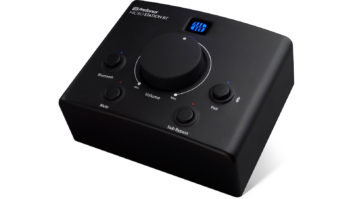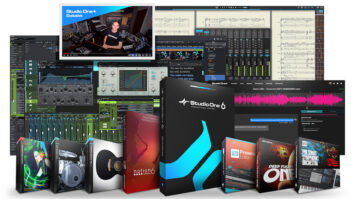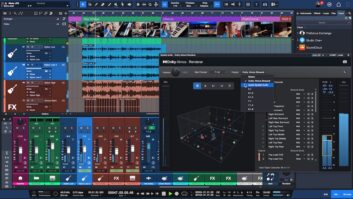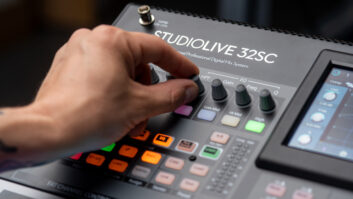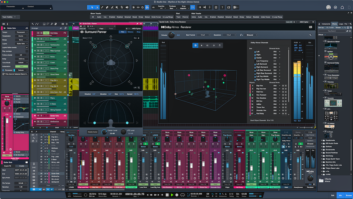
It’s been six years since PreSonus launched its popular DigiMax line, and nearly four years since the DigiMax last received a facelift in the DigiMax LT and DigiMax 96K models. Building on many of the LT’s technical aspects, the DigiMax FS is the latest in the line aimed directly at project studios needing lots of high-quality microphone preamps and simple cross-platform interconnectivity and routing flexibility. The DigiMax FS is an 8-channel Class-A microphone and instrument preamplifier with ADAT optical and 96kHz dual SMUX input and output conversion as its primary selling feature.
MEET THE FS
The control panel of this robustly constructed 1U box reveals that all inputs are up front, which might not be the best solution for everyone but, as we’ll discover later, the reasoning behind this design decision was a good one. The inputs are Neutrik Combo connectors comprising balanced XLR and ¼-inch TRS hi-Z instrument inputs on channels 1 and 2, while inputs 3 through 8 offer mic or balanced line-level inputs. All eight microphone inputs include selectable 48-volt phantom power (in groups of four) and individual preamp gain control. Input is measured only by red “clip” indicators. The line-lump power adapter features a lock-nut for ensuring that no loud pops will result from accidental pulls to the power cord.
ALL ABOUT THE I/O
What really sets the DigiMax FS apart from the pack is its ability to expand on the often-underused, or completely sedentary, ADAT ports of our project studio equipment. If you’re like most home recordists, you probably find yourself maxing out the analog inputs of your audio interface on a regular basis, wishing it had more — and better-sounding preamps, too! Similarly, you’ve likely cursed the fact that you see a perfectly good set of ADAT Lightpipe receptacles on your interface or digital mixer, but with no compatible gear to make use of them. Its back panel is absolutely loaded with I/O, featuring SMUX-configured ADAT input and output (dual sets of multiplexed optical ports for up to eight channels of 88.2 or 96 kHz), BNC word clock connectors and 24 analog connectors arranged into three sections — all of which are simultaneously usable.
The first section groups eight balanced ¼-inch TRS DAC outputs that are directly sourced from the ADAT input. This conveniently converts ADAT optical signals to analog outputs, ideal for sending additional monitor mixes or alt sends from a digital mixer or DAW whose analog outs are already maxed. The next section has eight TRS direct analog outputs, giving you the option of sending line-level outputs straight from the preamps to a console or backup device during mixing or live recording. The third group comprises eight TRS connectors that are configured as insert points for each input on the DigiMax FS — a very cool feature. Returns 1 and 2 also act as the line-level inputs for channels 1 and 2. You can daisy-chain unlimited DigiMax FS units, and a 75-ohm Terminate switch allows you to terminate the word clock signal on the final unit. Now you understand why the bulky Combo inputs are placed up front.
GOT THE JITTERS?
The DigiMax FS is the first to feature PreSonus’ new JetPLL jitter-reduction technology. Developed by TC Electronic, it uses a wide range and variety of frequencies and noise shaping to remove nearly all audio-band jitter with the aim of providing superior converter performance, plus fast-locking and tight synchronization. The Internal Clock selector on the far right of the front panel allows you to set the DigiMax FS as the word-clock master at various sample rates (44.1, 48, 88.2 and 96 kHz), while External Sync toggles between ADAT/slave sync and BNC word clock, which are indicated by red and blue backlighting, respectively.
CLEAN AND VERSATILE
The business end of the DigiMax FS sounds fantastic. Its preamps are capable of huge gain boosts while remaining neutral to the signal, and deliver an uncompromising, clean sound that is truly impressive, especially for this price range. Even when I pushed them really hard on distant miking, they produced an uncolored and consistent sound that I’d classify with some of the best transformerless designs out there.
I recorded tracks using a Røde Classic II and compared the PreSonus unit with several stand-alone and audio interface preamps ranging from budget to high-end models, and I was particularly impressed with the DigiMax FS’ transparent highs, and its dynamic and present midrange. It produced a generally fuller and bigger sound than I was used to hearing from pre’s in its price range. Its excellent transient response resulted in some of the most spacious sounding stereo recordings I’ve captured, and its two instrument DI’s were equally sweet on guitar and electric bass, again revealing a lovely low-midrange gusto that would normally be missing from pre’s in this price range. This brings up a good point: Because much of your typical audio interface’s cost is in its converters and not necessarily in its pre’s, you just may find that using the DigiMax FS as a front end improves upon the sound of your more expensive interface.
Like its predecessors, the DigiMax FS works well with DAWs because its analog and digital outputs are active simultaneously. I was able to monitor the analog outputs with zero latency while recording digitally. With no real metering to speak of on the DigiMax FS, you must rely on the meters within your DAW. Similarly, the unit’s lack of discrete phase buttons means DAW users will need to perform inversions in software. Curiously, the manual skips around discussing the gain section in any detail, but I’m happy to report that due to the unit’s excessive headroom, it’s more than happy with hot signals, so the lack of input padding isn’t missed.
PLAYS NICE WITH OTHERS
On the technical end, the DigiMax FS’ ADAT bridging allowed me to finally turn my Digidesign 96 I/O (which comes standard with only eight ADAT optical inputs and outputs) into the 16-channel audio interface that it truly is. Using a pair of Toslink Lightpipe cables, I created bidirectional communication between the DigiMax FS and my 96 I/O using the 96 I/O’s eight channels of ADAT optical I/O (the 96 I/O doesn’t support the SMUX configuration) and set the DigiMax FS to be the master clock for the system at 44.1 kHz. This allowed me to feed eight additional channels to Pro Tools and simultaneously receive eight channels digitally, with the FS converting them through its DAC outputs. This allowed for more physical aux sends in my PT rig, as well as for luxurious sundry tasks, such as supplying stems to tape decks, submix components to headphone stations, outputs for surround monitoring and more, without having to tie up valuable Digidesign interface channels. I could quickly configure this setup in Pro Tools’ Hardware Setup and busing pages, and then enjoy a plethora of new routing options. And, remind me again, this convenience is all from a preamp?
I also tried slaving the DigiMax FS to my Apogee AD-16X, which does support SMUX, and once again, synchronization was brilliantly fast and robust. Thanks to PreSonus’ JetPLL technology, the DigiMax FS ensures that any incoming digital source shares its jitter spec, regardless of which unit serves as the master clock. After subjective tests between the much pricier 96 I/O, Apogee’s acclaimed Big Ben C777 chip within the AD-16X and the JetPLL technology, I feel confident that the DigiMax FS’ clocking abilities compare favorably.
Having the ability to insert an external EQ or compressor after the preamp but before the A/D converter is such a huge boon to the DigiMax FS, it cannot be overstated. The converters sound on par with my Digidesign unit and, arguably, even my beloved Apogee. I honestly don’t know what kind of magic PreSonus is pulling off here.
SOMETHING TO CHEW ON
Digimax FS is a multitalented powerhouse. As an expansion device, it serves many cool functions, including the ability to add high-definition sample rates and extremely high-quality clocking to older interfaces or digital mixers, or to act as a stand-alone ADAT/SMUX-to-analog converter. Since so many interfaces feature only one or two mic inputs, it’s also a great and inexpensive way of adding the immediacy of always-active microphones to a compact recording setup. I became greedy and wished for discrete AES/EBU or S/PDIF on each channel for some very esoteric purposes in my setup, but I’m assuming that customers who buy this product will be interested mainly in its ADAT provisions, and won’t miss those features at all.
Bottom line: The DigiMax FS provides eight transparent sounding mic pre’s, an impressive audio spec at any price range, first-rate construction, highly flexible routing options and rock-solid clocking. Purity in the project studio just got more affordable. Price: $799.
PreSonus, 800/750-0323, www.presonus.com.
Jason Scott Alexander is a producer/mixer/remixer in Ottawa, Ontario.

